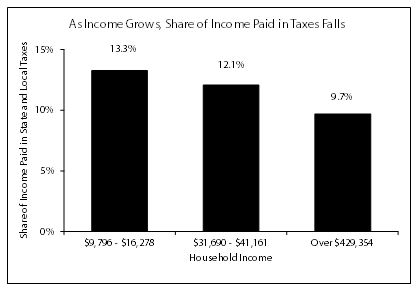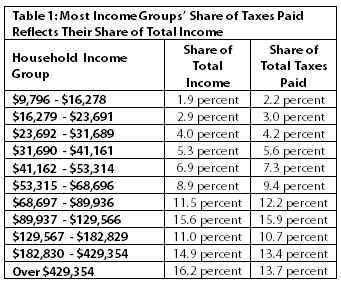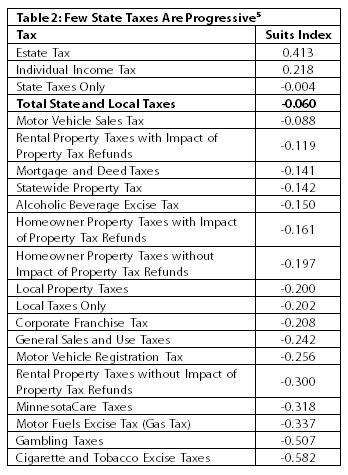Policy choices matter in ensuring that Minnesota’s tax system is both fair and raises enough revenue to fund the state’s priorities. When considering how to improve the state and local tax structure, Minnesota policymakers should take into account the main facts:
- The difference between the share of income that the wealthiest pay in taxes and the share that the average Minnesotan pays has grown. Reversing that trend should be a priority.
- Taxes are a lower share of Minnesotans’ income today than in the mid-1990s, and are not raising adequate revenues to avoid persistent budget deficits.
As Income Grows, the Share of Income Paid in Taxes Falls
The wealthiest one percent of Minnesotans (those with household incomes over $429,354) paid 9.7 percent of their incomes in total state and local taxes. This is significantly less than the 12.1 percent paid by a middle-income household making $31,690 to $41,161.[1]
Since 1990, tax fairness in Minnesota has declined.[2] Two factors explain the growing gap. One is growing income inequality. In other words, the benefits of economic growth have gone disproportionately to those with the highest incomes.[3]
But policy choices are also part of the picture. Perhaps the most important is the ongoing shift in the mix of taxes, away from state taxes to more reliance on local property taxes, which are based on home value and not as closely linked to someone’s ability to pay. In 2006, local taxes made up 26.4 percent of total taxes. They increased to 29.1 percent of total taxes in 2008, and are projected to increase to 31.1 percent of total taxes in 2013.
Taxes Have Become a Smaller Piece of Minnesotans' Budgets
Taxes are a smaller share of Minnesotans’ household budgets today than in the mid-1990s. Tax cuts enacted in the late 1990s and early 2000s, coupled with income growth, mean that Minnesotans have seen a nearly 11 percent drop in the share of their incomes they are paying in taxes. In 1996, Minnesotans paid 12.9 percent of their incomes in state and local taxes. By 2008, this had fallen to 11.5 percent.
Between 1997 and 2001, policymakers passed a significant number of tax cuts. Cuts were made to property taxes, income taxes and motor vehicle registration taxes, and one-time rebates totaling $3.7 billion were enacted in each legislative session between 1997 and 2001.[4]
Experience since that time demonstrates that those cuts went too far. Combined with the revenue drops in response to tough economic times, Minnesota has faced frequent revenue shortfalls that made it difficult to fund the state’s priorities.
Most Income Groups Pay in Proportion to their Share of Total Income
High-income Minnesotans pay a significant share of all taxes paid in the state. This reflects the fact that high-income Minnesotans have a significant share of all income in the state.
In fact, most Minnesota income groups pay in rough proportion to their share of total income, although middle-income groups tend to pay slightly more than their proportionate share and the highest income groups pay less.
The income group with the largest gap between its share of the state’s income and its share of total taxes is those with incomes over $429,354 (the wealthiest one percent). This group of Minnesotans had 16.2 percent of all income in the state, but paid 13.7 percent of total taxes.
Some Taxes are Distributed More Evenly Than Others
While most Minnesotans pay about the same share of their incomes in taxes, how much of each tax they pay varies with their income. For lower-income Minnesotans, sales and property taxes make up the largest pieces of their tax bills, while higher-income Minnesotans pay more through the state income tax.
That means that changes in a particular tax will not be evenly felt across the board.
Minnesota’s estate tax and individual income taxes are the state’s only progressive taxes – meaning that the higher one’s income, the larger share of that income paid for the tax. All other taxes that Minnesotans pay are regressive, taking a higher percentage of a low- or middle-income household’s income than for the wealthiest households. Taxes on gambling and on cigarette and tobacco products do this to the greatest extent.
In Minnesota, the income tax only partially offsets the impact of other state and local taxes on low-income and middle-income households.
Table 2 illustrates how regressive or progressive different taxes are, demonstrated by the Suits Index. A Suits Index above zero means the tax is progressive, and a Suits Index below zero means the tax is regressive.
Tax Reform Can Make the Tax System More Adequate and More Fair
Minnesota’s tax system is not meeting our needs. Tax reform is needed so that the tax system raises enough revenue to end the cycle of budget deficits and gimmicks that have plagued our state. And tax reform is needed so that low- and middle-income Minnesotans aren’t asked to pay more than their fair share.
By Nan Madden